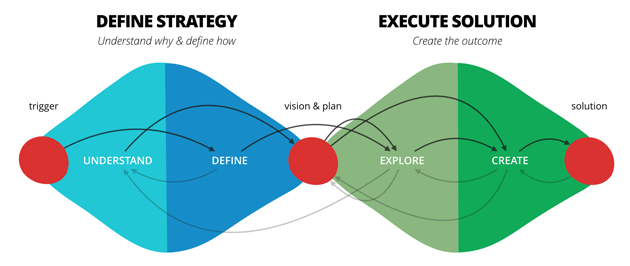
The Double Diamond: Strategy + Execution of the Right Solution
Joining strategy together with the execution of the right solution challenges most teams today. It’s difficult for many reasons. Defining a strategy is not a static exercise. Predicting the future is difficult, full of uncertainty, and new information is always being discovered. Complicating things further, teams often divide responsibility for strategy and execution. This makes it harder to adapt to new information.
Teams often focus on the delivery of a thing, instead of its business impact. This happens when we define success by short timeframes, and performance relates to output. We also tend to rely on our intuition or acumen, without seeking any validation. Even with years of experience in a domain, intuition can be flawed by our biases. Left unchecked, we define and pursue solutions before fully understanding the opportunity space.
Creating successful products requires the skills, expertise and craft of many people. Engineers, specialists, analysts, strategists, designers, researchers, architects and marketers work together. We define a desired future state, before executing upon that vision as one. With such a group of people come diverse personal characteristics – analytical, creative, strategic, pragmatic. And many approaches to working – structured, unstructured, empirical, theoretical. Orchestrating such an effort calls for ways of working together toward common goals. A way of thinking that is flexible enough for different circumstances – not a prescriptive book of rules. We need something that guides us to define adaptive plans that respond well to new information. A model that helps us to work together to achieve real outcomes together.
The Model
The ‘Double Diamond’ process maps the divergent and convergent stages of a design process. Created by The British Design Council, it describes modes of thinking that designers use. The Council’s origin is Industrial Design – which is about creating tangible objects. As such, the model seems like a linear process. It describes significant up-front design, before going on to produce a final solution. Working this way means that solutions are generally perfected before public release. That’s because it’s expensive to change a physical product after it has shipped. Another effect is that a lot of time passes before knowing it’s efficacy in a real market.
For software products or services, we take advantage of the malleable nature of what we create. Software is easier to change, so we don’t need to perfect the entire solution up front. Instead, we create smaller packages of value for release. Then we respond to what is learnt in a real market to refine and adapt the architecture of the product. When we do this, the initial solution informs the future, and our strategy adapts.
See below the modified Double Diamond model, adjusted for software products and services.

Understand
The journey begins with a trigger. This could be an idea, some insight, a change in the market, a macro economic change. Before responding to the trigger with a vision or plan, we first seek to understand the current condition. This phase is divergent and exploratory – it’s a search for new questions. Through observation and enquiry we reveal customer behaviour and business drivers. Opportunities are identified for further consideration.
Define
From a place of some understanding, we begin to synthesise knowledge into insight. This focuses on the most compelling opportunities to pursue. It’s about converging on a vision and defining the first expression of our plans to occupy a future position. We assess the viability and impact of our plans, and determine how to measure success.
This initial strategy guides the execution of a solution, but strategy is never complete. A strategy should adapt when we make new discoveries. It doesn’t need to define all details of a solution. Instead, the focus should be on the desired outcomes or impact to achieve.
Explore
With a vision in place, it’s time to explore the best potential solutions. We know what to achieve, and by exploring and validating options, we find the best ways to succeed. This is a divergent and iterative activity. Details and requirements have not been defined – instead, the right solution is discovered.
Create
As we gain confidence in the solution, exploration gives way to engineering. Now we’re creating and optimising working software. The opportunity here is two-fold. First, a working solution delivered to market. Second, we gather real market feedback. As a result, our understanding deepens, and new discoveries influence an ever-changing strategy. Software engineering is not merely execution of a plan, it also defines strategy.

Understanding the phases of the Double Diamond and how they interrelate is important. It helps decide the right methods and activities for pursuing a problem or opportunity. The model scales well to accommodates many situations. Optimising an existing business model using continuous improvement is different to new product development. These call for their own tools and methods. Enterprise innovation – where integrated strategies define a full programme of work – is different again. Yet, for each example, we can apply the Double Diamond to help frame strategy and execution of the solution.
Disclaimer: The statements and opinions expressed in this article are those of the author(s) and do not necessarily reflect the positions of Thoughtworks.














